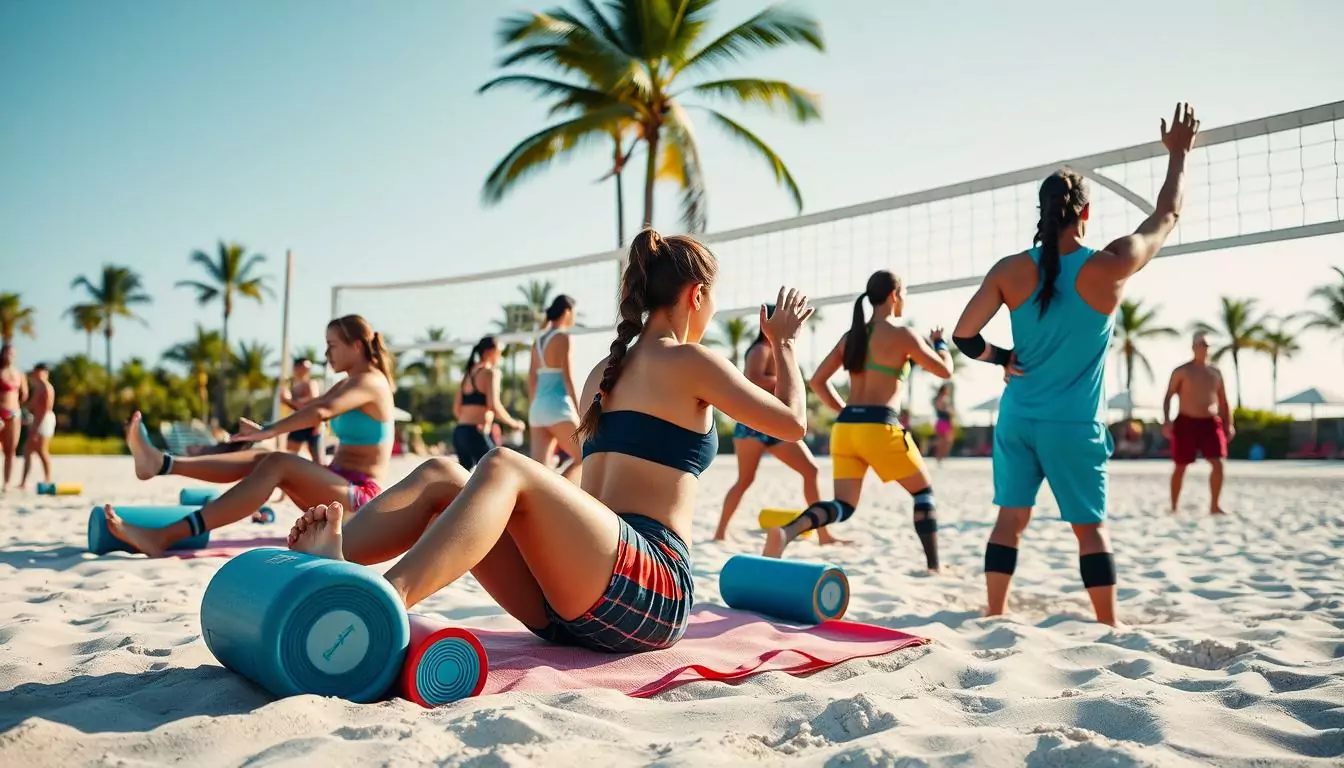Did you know that ankle injuries make up over 50% of all beach volleyball injuries? This shows how vital injury prevention and protection are for sand court athletes. Beach volleyball is a dynamic sport that needs special care to keep players healthy and performing well.
Players face many injuries, from ankle sprains to lower back and shoulder pain. These can keep them out of the game for a long time. But, with the right steps and gear, athletes can lower their risk and play safely.
Key Takeaways:
- Wear supportive, well-fitted athletic shoes to stabilize the feet and ankles
- Engage in proper warm-up routines to minimize the risk of muscle strains and sprains
- Strengthen key muscle groups, such as the ankles, shoulders, and knees, for improved stability and injury prevention
- Take advantage of the natural cushioning provided by soft sand playing surfaces to reduce impact on joints and muscles
- Stay hydrated and protect your skin from harmful UV rays to maintain optimal performance and health
By focusing on injury prevention and protection, beach volleyball players can avoid setbacks. This helps them stay competitive and enjoy the sport for years. With the right approach, playing on the sand can be safe and exciting.
Common Beach Volleyball Injuries
Beach volleyball is a thrilling sport but comes with injury risks. The California Beach Volleyball Association reports nearly 8,000 active members. Most injuries happen during defensive and attack moves, with ankle, knee, and finger injuries being top issues.
Ankle injuries are the most common in beach volleyball, causing a lot of downtime. These can be sprains, fractures, or tendonitis, including the “sand toe” condition. Knee injuries, like patellar tendonitis and jumper’s knee, also occur due to jumping and landing.
Finger injuries are common, caused by blocking, setting, and digging. These can be tendon and ligament injuries, or even fractures and dislocations.
Overuse injuries are also common, with lower back pain, shoulder pain, and patellar tendinitis being the top three. Lower back pain and spondylolysis can happen from spiking, which arches the back. Shoulder issues, like tendinopathy and rotator cuff problems, are also common due to the sport’s high-impact nature.
Many injuries can be prevented with proper warm-ups, cool-downs, and exercises. Strengthening legs and shoulders, correcting techniques, and using protective gear like patellar tendon straps can help.
Proper Warm-up and Cool-down Routines
Getting ready for a beach volleyball match is key to avoid injuries. Cold muscles are more likely to get hurt, making a good warm-up very important. A mix of warm-up exercises can get your muscles and joints ready for the game.
Isometric exercises, like holding a position, are a great start. They help your muscles get ready for more active movements. Jogging, which gets faster, also raises your heart rate and blood flow. Side shuffles and lunges are good for the warm-up too, as they mimic the movements on the sand.
Dynamic stretching, which involves smooth movements, boosts flexibility and range of motion. Studies show it’s better than static stretching for power, flexibility, and range of motion. Adding these exercises and some light cardio can get you ready for the game.
After playing, it’s vital to cool down right. Light jogging or walking helps your body relax and recover. Remember, proper technique is key to avoid injuries, like not grabbing the net. A good warm-up and cool-down routine can help you play better and stay safe on the sand.
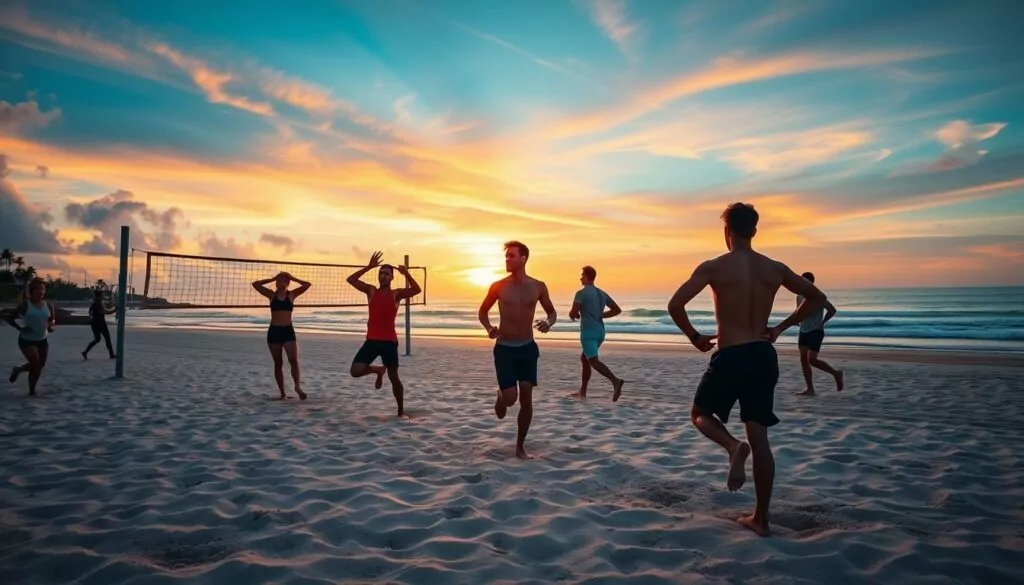
Knee Protection: Pads and Braces
Knee injuries, like patellar tendonitis and jumper’s knee, are common in beach volleyball. The sport’s high-impact nature strains the knee, leading to painful injuries. To avoid these, it’s key for players to wear the right knee protection.
Patellar tendon straps are a great solution. They help reduce stress on the tendon, easing pain and swelling. The Ascender Unloader Knee Brace by Icarus Medical has been shown to decrease pain by 59%, improve function by 37%, and increase activity by 87%.
Knee pads are also vital for beach volleyball players. They protect the knees from sand impacts and prevent serious injuries. Studies indicate knee pads can cut knee injury risk in beach volleyball by up to 50%.
Knee braces are essential for those with knee problems or seeking extra support. Neoprene braces offer moderate support during jumps and lateral movements, making them popular. Hinged braces are best for those with past knee injuries, providing stability but limiting mobility.
Compression knee sleeves are a lightweight, flexible option. They help with acute pain by providing compression and warmth. Yet, they offer the least structural support.
Patella knee braces are good for those with existing knee issues or injury prevention. They protect the kneecap, reducing pain and swelling. But, they might not be right for everyone due to the pressure they apply.
Using the right knee protection gear can greatly lower knee injury risk in beach volleyball. Knee injuries are common, affecting 30-45% of athletes. Wearing knee protection can make athletes 3 times less likely to get severe knee injuries.
Ankle Support and Injury Prevention
Ankle injuries, like sprains and fractures, are common in beach volleyball. Players can use ankle braces or taping for extra support. Balance board training also helps prevent ankle sprains.
Lateral ankle sprains are the most common, caused by the foot rolling inward. High ankle sprains and fractures are rarer but serious. Ankle braces, like the Ultra Zoom, can prevent these injuries with its special design.
Beach volleyball players can lower their injury risk by using these prevention methods. Modern ankle braces are designed for sports, not just for support.
| Ankle Brace | Recommended For | Price |
|---|---|---|
| Ultra Zoom Ankle Brace | Players with 0-1 previous ankle injury for prevention and sports | $31.95 |
| Ultra 360 Lace-Up Ankle Brace | Players with 0-4 previous ankle injuries for recovery, prevention, and sports | $61.95 |
Wearing ankle braces is key for volleyball players to avoid injuries. By focusing on ankle support, players can stay safe and perform well.
“Implementing a complete injury prevention program can cut injury rates by up to 40% in beach volleyball.”
Sun Protection for Beach Volleyball Players
Beach volleyball players face the sun’s harmful UV rays every time they play. It’s vital to protect our skin from sunburns, long-term damage, and skin cancer.
To block the sun’s rays, we should apply high-SPF sunscreen before playing. Sun hats or visors help cover our faces and necks. Sunglasses or goggles protect our eyes from glare and UV rays.
Playing outside also means we risk dehydration and heat illnesses. Drinking plenty of water and wearing cool clothes helps us stay cool.
| Sun Protection Essentials | Benefits |
|---|---|
| High-SPF Sunscreen | Shields skin from harmful UV rays |
| Sun Hats or Visors | Provides additional coverage for face and neck |
| Sunglasses or Goggles | Protects eyes from sun glare and UV exposure |
| Moisture-Wicking Apparel | Helps manage sweat and keep players cool |
By following these simple steps, we can enjoy beach volleyball while keeping our health safe.
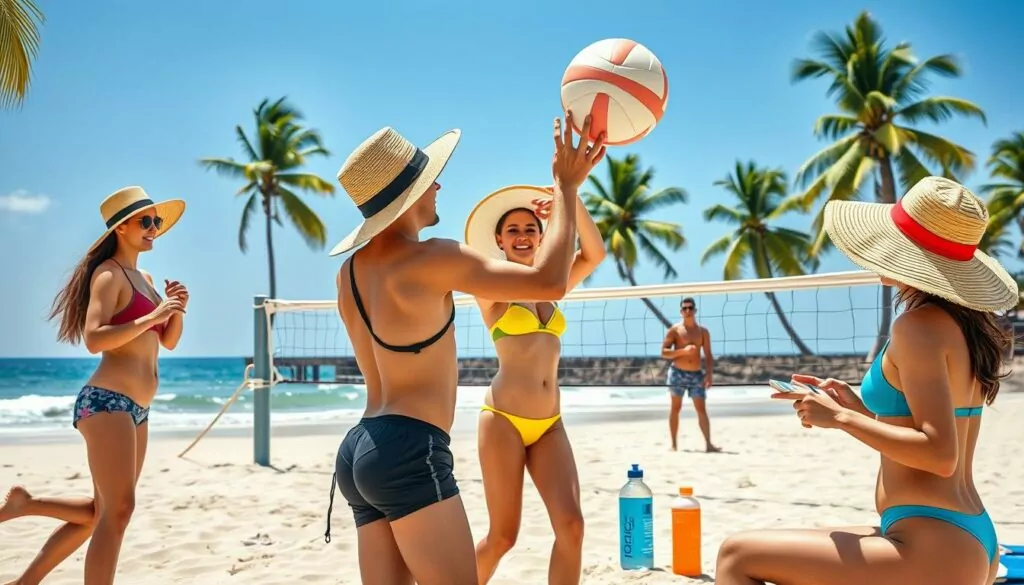
“Protecting your skin from the sun’s harmful rays is key, for your health and your game.” – Dr. Sarah Johnson, Sports Dermatologist
Hydration and Nutrition for Sand Athletes
Playing beach volleyball in hot, sandy conditions can cause a lot of fluid and electrolyte loss. It’s key to stay hydrated and eat right to keep energy up, avoid cramps, and recover well. Athletes should drink lots of water before, during, and after playing. They might also want to use sports drinks to replace lost minerals.
Eating a balanced diet with carbs, protein, and healthy fats is important for energy before games. After playing, eating protein helps muscles heal and grow. This is vital for recovery.
Top beach volleyball players show how important hydration and nutrition are during tournaments. Studies have looked at what elite players eat and drink, giving us clues on how to fuel our bodies for the sport. There’s also research on how carbs can boost performance, helping us find the best nutrition for beach volleyball.
| Hydration and Nutrition Recommendations for Beach Volleyball Athletes |
|---|
|
“Proper hydration and nutrition are the foundation for peak performance in beach volleyball.”
By focusing on hydration and a balanced, sport-specific diet, beach volleyball athletes can perform at their best.
Recovery Techniques for Beach Volleyball
Recovery is key for beach volleyball players to stay at the top of their game and avoid injuries. Foam rolling and massage guns help release muscle tension and boost blood flow. Adding resistance band exercises targets specific muscles and boosts flexibility.
Getting enough sleep, nutrition, and hydration is also vital for recovery. Rest and recovery help players avoid injuries, feel better, and play their best on the sand.
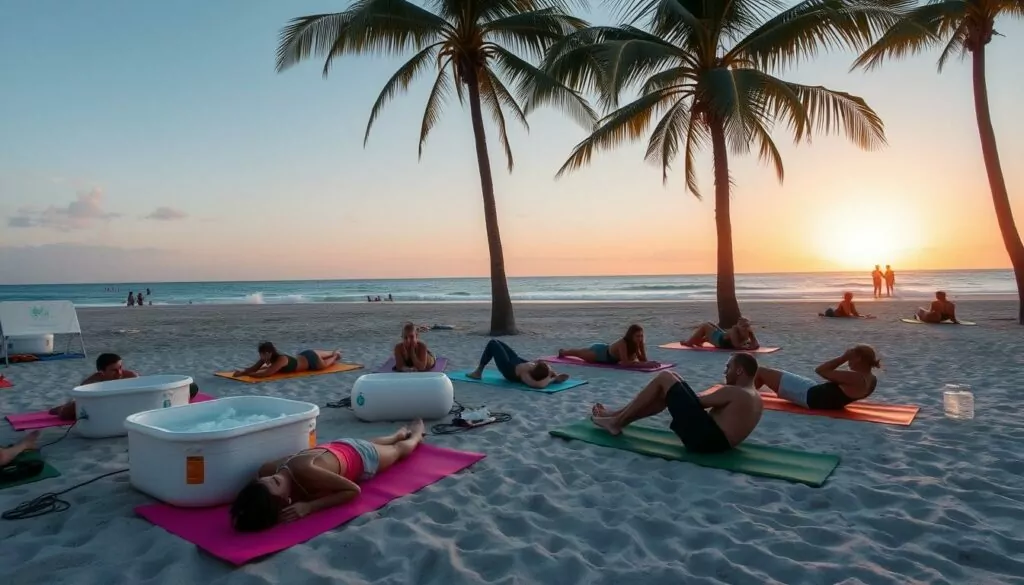
A study showed 477 volleyball injuries in one season, with common spots being the ankle, fingers, knees, and shoulders. Starting an injury prevention program can cut acute ankle sprains in half, as another study found.
By focusing on recovery, beach volleyball players can lower injury risks and improve their game. Using foam rolling, massage guns, resistance bands, and proper rest, nutrition, and hydration can make a big difference in success on the sand.
“Proper recovery is essential for beach volleyball players to perform at their best and prevent injuries.”
Conclusion
Injury prevention is key in beach volleyball. Knowing common injuries and using the right techniques can help players stay safe. This way, they can enjoy the sport for many years. Whether you play competitively or just for fun, keeping safe should be your main goal.
The sand can be tough on players, leading to specific injuries. Ankle sprains are common due to the stress from jumping and changing direction. Knee injuries, like patellar tendinopathy and ACL tears, often happen from repetitive jumping. Shoulder and finger injuries are also common, caused by overhead movements and unpredictable ball contact.
To avoid these injuries, players need a solid prevention plan. This includes:
- Doing thorough warm-ups and cool-downs to get ready and recover
- Wearing protective gear like knee pads and ankle braces
- Doing exercises to improve balance and reduce joint stress
- Staying hydrated and eating right to help muscles recover
- Getting enough rest and recovery time
By being proactive, players can stay healthy and keep loving the game. With the right steps, they can lower their injury risk. This lets them perform well and have a long, successful beach volleyball career.
As beach volleyball season gets closer, focus on staying safe and healthy. Knowing the common injuries and using protective measures is key. By living a healthy lifestyle, players can excel in this exciting sport.
Beach Volleyball Attire and Style Guide
As a passionate beach volleyball player, I know how important the right clothes and gear are. The official rules and the usual two-player teams make a big difference. The right beach volleyball clothes can change your game.
From uniforms and shorts to shoes and accessories, the right gear makes you feel confident and ready. In this guide, I’ll share what you need for beach volleyball clothes and gear. Plus, tips on how to look great on the court and keep your gear in top shape.
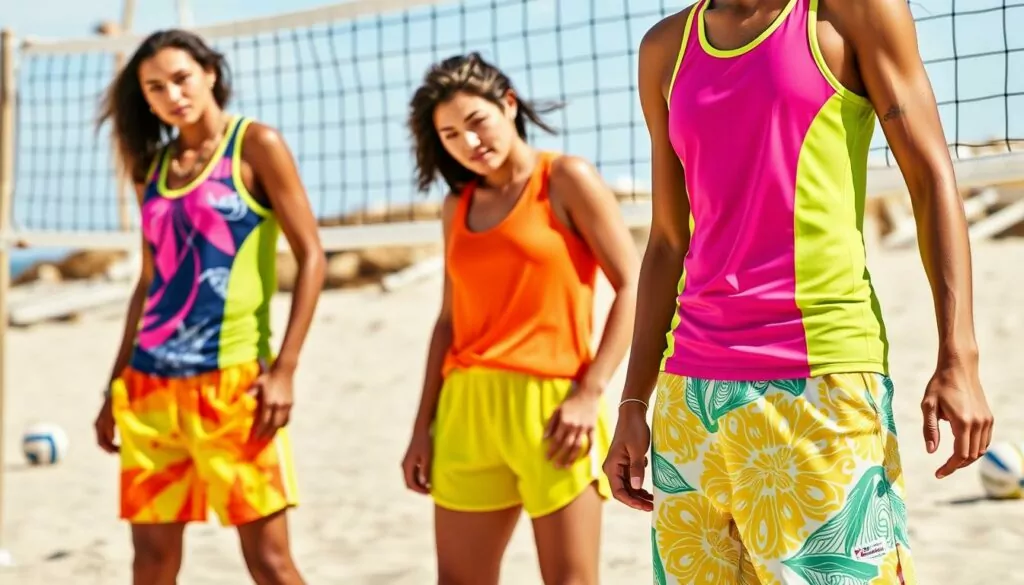
Key Takeaways
- Invest in high-quality, breathable beach volleyball uniforms that allow for maximum mobility and comfort on the sand.
- Choose beach volleyball shorts that provide the right balance of coverage, flexibility, and style.
- Opt for lightweight, moisture-wicking shirts and tanks that keep you cool and dry during intense beach volleyball matches.
- Prioritize proper footwear with traction and support to prevent injuries and enhance your performance on the sand.
- Accessorize with items like hats, sunglasses, and arm sleeves to protect against sun exposure and elevate your beach volleyball look.
Functional Beach Volleyball Uniforms
Beach volleyball uniforms are key for both performance and comfort. They must be breathable and moisture-wicking to keep players cool and dry. Arm sleeves, popular for over 20 years, help prevent injuries and keep players cool.
Uniforms also play a role in team unity and branding. Custom designs, like sublimated arm sleeves, let teams show off their colors and logos. This boosts team pride and sense of belonging.
Players have many uniform choices. Sleeveless jerseys and spandex shorts offer freedom and air, while long-sleeve jerseys with leggings provide support and style options. The choice depends on personal comfort and the level of coverage needed.
The perfect uniform balances function, style, and team spirit. Using breathable fabrics and adding custom touches makes players feel confident and ready to play.
“Arm sleeves provide muscle compression, reducing injury risks and fatigue.”
Choosing the Right Beach Volleyball Shorts
Choosing the right shorts for beach volleyball is key to your comfort and performance. You need to think about the inseam length and the fabric. These factors are important for finding the perfect shorts.
Shorter inseams, from 3 to 5 inches, are best for beach volleyball. They let you move freely on the sand. This is important because you’ll be diving, jumping, and changing direction a lot.
The fabric of your shorts is also critical. Look for materials that wick away moisture. This keeps you dry and comfy during intense games. Polyester or nylon blends are good because they breathe and prevent chafing.
The fit of your shorts matters too. Compression shorts offer support, while loose styles give you more room to move. Choose based on what you prefer and what you need for the game.
The best shorts let you move freely, stay dry, and feel good. Focus on inseam length, fabric, and fit to find your ideal shorts. This will make your beach volleyball experience better.
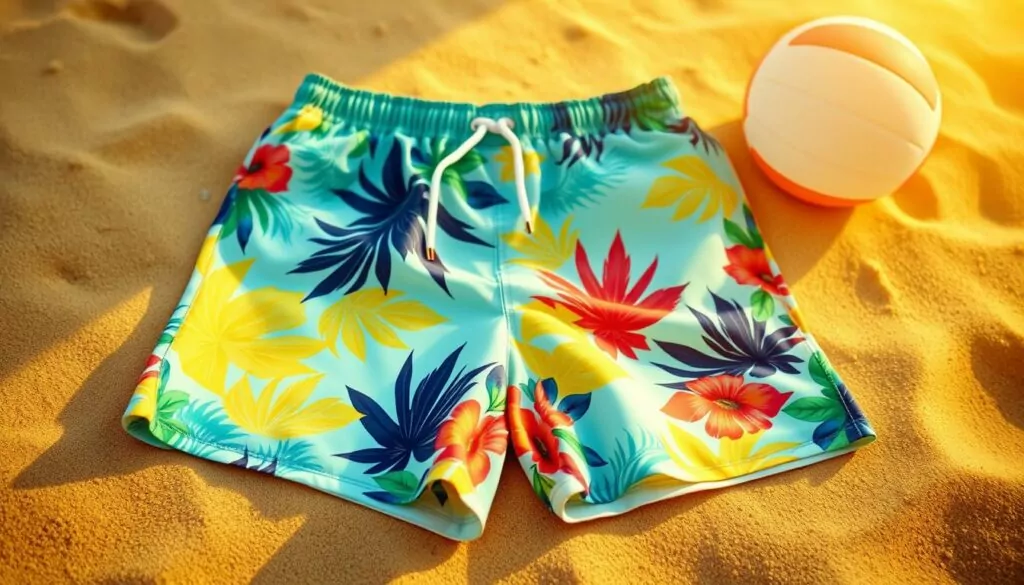
Investing in good beach volleyball gear improves your game and fun. The right shorts will help you play your best on the beach.
Top Picks for Beach Volleyball Shirts and Tanks
Choosing the right shirts and tanks for beach volleyball is key. They should be light, breathable, and dry quickly. This keeps you comfortable and focused during games. Racerback designs are great because they let you move freely without getting stuck.
Some shirts also have UV protection. This is a big plus for playing outside a lot. It helps protect you from the sun’s harmful rays.
- Lightweight, breathable fabrics that wick away moisture
- Racerback design for unrestricted movement
- Built-in UV protection to shield from the sun’s rays
When picking beach volleyball tops, think about both how well they perform and how they look. Top brands offer many styles that are both functional and fashionable. Good beach volleyball shirts and tanks help you play your best, both on and off the court.
| Product | Key Features | Price |
|---|---|---|
| Under Armour Women’s Tech Tank | Lightweight, moisture-wicking fabric, racerback design, UPF 30+ sun protection | $29.99 |
| Nike Dri-FIT Women’s Victory Tank | Breathable, sweat-wicking material, loose, flowy silhouette, UPF 40+ sun protection | $35.00 |
| Adidas Women’s Designed-2-Move 3-Stripes Tank | Moisture-absorbing AEROREADY fabric, sleeveless racerback, semi-fitted style | $30.00 |
“The right beach volleyball top can make all the difference in your game. Look for features like breathability, moisture-wicking, and UV protection to keep you performing at your best.”
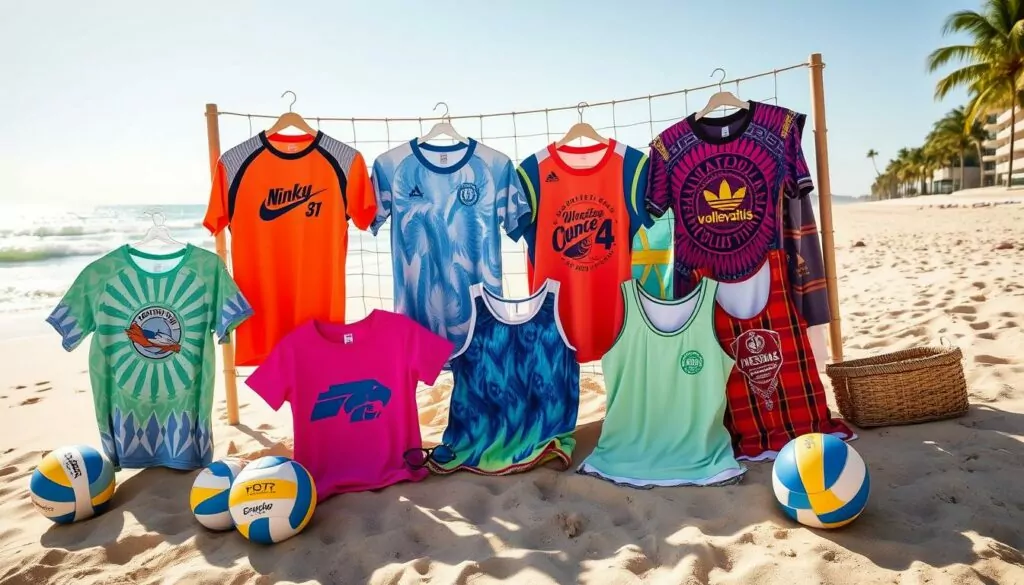
Footwear Options for Sand Play
Beach volleyball requires the right shoes for grip, stability, and comfort on sand. Unlike indoor courts, beach sand is loose and uneven. This calls for shoes that prevent slipping and falling.
Non-marking rubber soles are key to avoid damaging indoor courts. Shoes with herringbone or hexagonal patterns offer great grip for quick movements.
Arch support and lateral stability are important in beach volleyball shoes. Good arch support prevents foot pain and boosts stability. Lateral support helps avoid ankle twists, common in the sport’s fast side-to-side movements.
Also, shoes with good cushioning reduce knee and joint strain during jumps and landings.
Top brands like Mizuno, Asics, and Nike make excellent indoor volleyball shoes. Adidas and Under Armour specialize in beach volleyball shoes. ASICS and Mizuno offer versatile shoes for both indoor and outdoor play.
The right beach volleyball shoes depend on the playing environment and the athlete’s needs. Beach volleyball shoes have less cushioning but better grip and are easy to clean. By focusing on traction, support, and weight, players can find the best shoes for their game.
| Brand | Product | Fit Rating | Quality Rating | Weight |
|---|---|---|---|---|
| ASICS | Men’s Netburner Ballistic FlyteFoam 3 Volleyball Shoe | 4.6 | 4.5 | 1.65 lbs |
| ASICS | Women’s Gel-Tactic Volleyball Shoes | 4.3 | 4.2 | 1.44 lbs |
| Nike | Men’s Volleyball Shoes | N/A | N/A | 1.76 oz |
| Mizuno | Momentum 2 Unisex Volleyball Shoe | N/A | N/A | 0.78 kg |
The U.S. volleyball shoes market was worth $XX million in 2021. It’s expected to grow at a CAGR of X% from 2021 to 2026. The U.S. leads the market, followed by Europe and Asia Pacific. Online retail is growing fast, along with specialty stores and sports chain outlets.
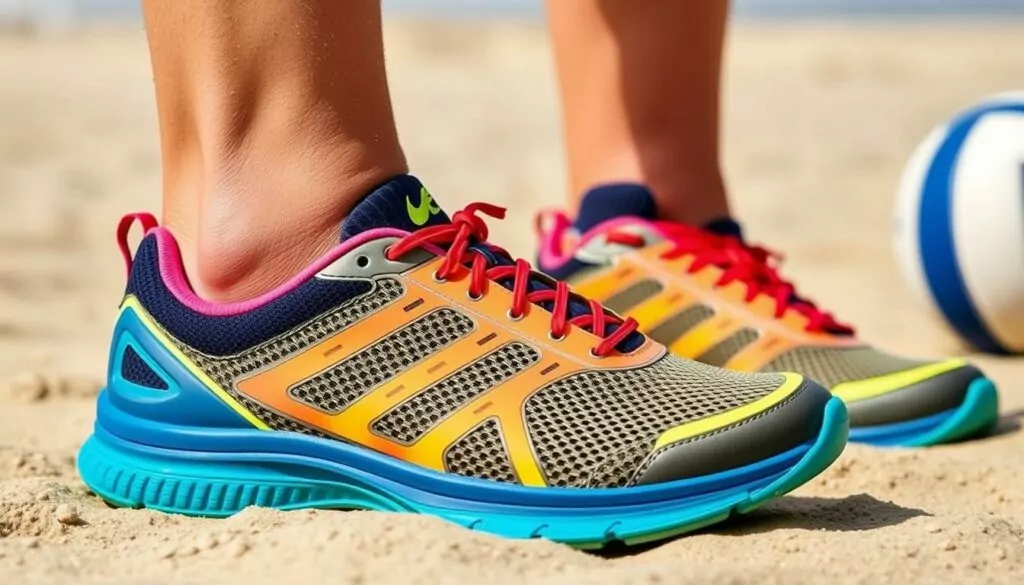
The volleyball shoes market is very competitive, with big names like Nike, Adidas, Asics, Mizuno, and Under Armour. The most used materials are synthetic leather, mesh, and rubber. What people look for includes brand reputation, quality, price, technology, and athlete endorsements.
As beach volleyball grows, so will the need for special shoes. Knowing what to look for in beach volleyball shoes helps players improve their game and stay safe.
Accessories: Hats, Sunglasses, and More
In the world of beach volleyball, accessories are as important as your uniform. Players often choose various accessories to improve their game and comfort. These include hats, sunglasses, and tools for recovery.
Sunglasses are key for blocking the sun’s glare. Choose ones with 100% UV protection to protect your eyes from harmful rays. A wide-brimmed hat helps block the sun, too, during the hottest hours.
It’s also important to stay hydrated. Dry eyes are more at risk for sun damage. Use eye drops and get eye exams every year if you spend a lot of time outside.
- Hand towels can improve grip and refresh you during matches.
- Athletic tape, foam rollers, resistance bands, and massage guns help prevent injuries and aid in recovery.
Choosing the right accessories can improve your game and protect your body. They make playing beach volleyball more enjoyable and successful. From sun protection to recovery tools, the right gear is essential.
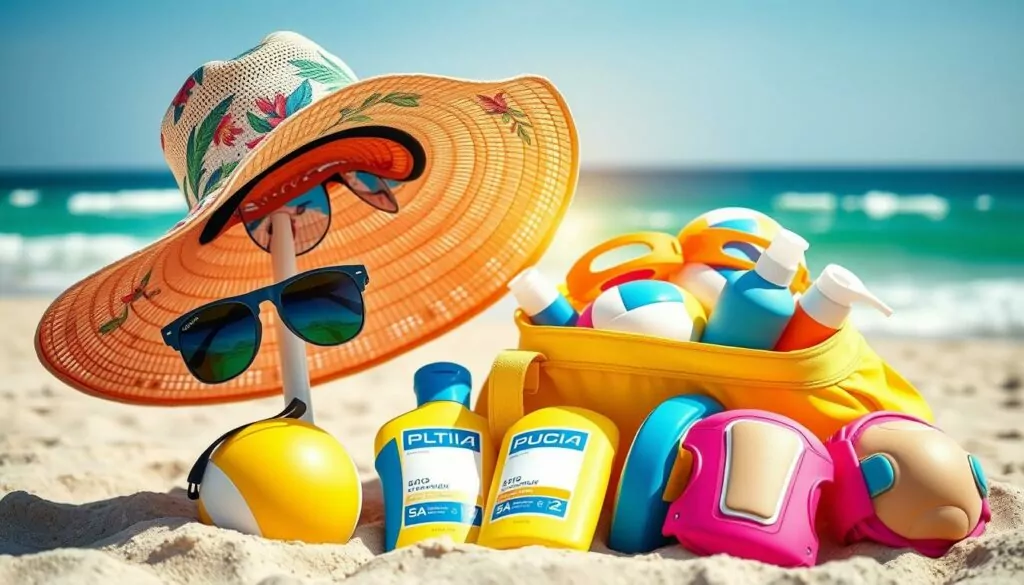
Protecting Your Eyes in the Sun
The sun’s UV rays can harm beach volleyball players’ eyes. Get sunglasses with 100% UV protection. A wide-brimmed hat also helps during the sunniest hours.
Staying hydrated is key, as dry eyes are more vulnerable to sun damage. Use eye drops and get eye exams yearly if you’re outside a lot.
“Protecting your eyes from the sun’s harmful rays is just as important as protecting your skin. Investing in quality sunglasses and a wide-brimmed hat can make all the difference in maintaining healthy vision on the beach volleyball court.”
By focusing on eye health and using the right accessories, beach volleyball players can enjoy the game while keeping their vision safe for years.
Beach Volleyball Hairstyles for Performance
For beach volleyball players, it’s key to keep hair back and out of the face. This helps them stay focused and perform well. Styles like braids, buns, or ponytails are great for managing long hair during games. Sweat-wicking headbands and other hair accessories also help keep hair away from the eyes, reducing distractions.
The ponytail is a top choice for long hair management in beach volleyball. It keeps hair back, ensuring it doesn’t block a player’s view or movement. You can also try a high ponytail or a ponytail with a braid for a stylish twist.
Buns are another great option. They can be styled in many ways to fit your style. A tight bun keeps flyaways away, while a messy bun adds a relaxed vibe. Braids are perfect for longer hair, as they’re both secure and stylish.
Sweat-wicking headbands are also very useful for beach volleyball players. These bands are breathable and absorb sweat, keeping hair out of the face and preventing eye irritation. This is important on hot, sandy courts.
Trying out different beach volleyball hairstyles and accessories can help players find the best way to manage their hair. With the right techniques, athletes can confidently play, showing off their skills and athleticism.
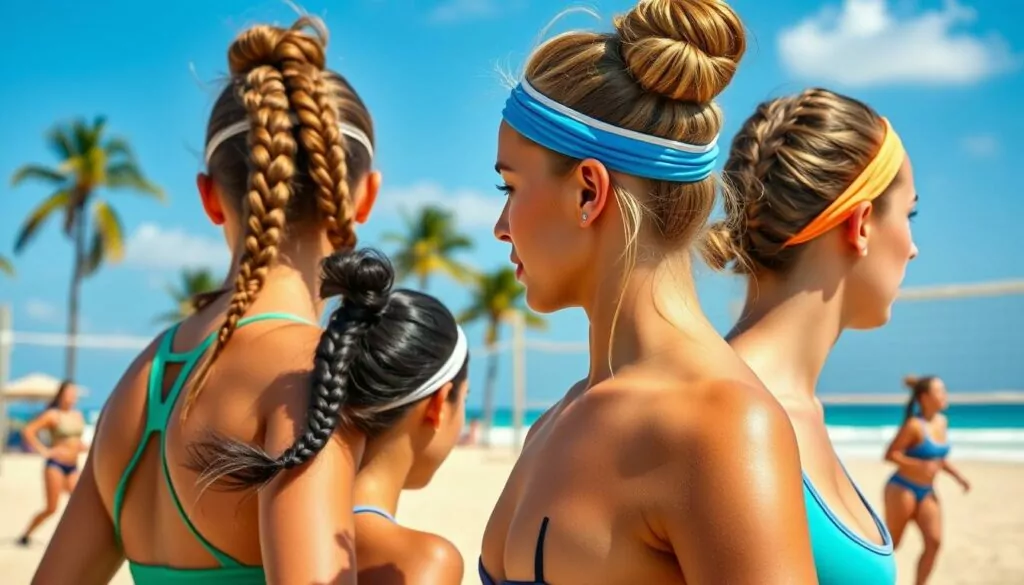
Caring for Your Beach Volleyball Apparel
Keeping your beach volleyball clothes in good shape is key. Follow the right washing steps, stay away from too much sun, and dry items by air instead of using a dryer. Knowing what each fabric needs helps keep your gear looking great for years.
For washing, use cold water and mild soap. Hot water and harsh cleaners can damage your clothes, making them less breathable and less stretchy. Choose detergents made for sports clothes to clean well without harming the fabric.
Drying by air is best for your beach volleyball clothes. Sunlight can make colors fade and wear out faster, so dry them in a breeze. This way, your clothes stay in good shape and don’t shrink or get distorted.
| Fabric Type | Washing Instructions | Drying Recommendations |
|---|---|---|
| Cotton | Gentle cycle, cold water | Air dry |
| Nylon/Spandex | Gentle cycle, cold water | Air dry |
| Polyester | Gentle cycle, cold water | Air dry |
By following these easy care tips, you can make your beach volleyball clothes last longer. Remember, taking good care of your clothes means they’ll be ready for the sand and sun.

Conclusion
The right beach volleyball style, gear, and clothes can change your game. From uniforms to shoes, each piece has a role. Taking care of your gear means you’ll play better and have more fun.
Quality shorts, shirts, and shoes boost comfort and confidence. Sun hats, sunglasses, and cool fabrics protect you from the sun. They help you stay cool and focused, even in tough weather.
Style and performance go hand in hand. The right hairstyle and accessories can improve your game. With the right gear, your beach volleyball experience will be better than ever.
“The right beach volleyball attire and accessories can make a significant difference in a player’s comfort, confidence, and overall performance on the sand.”
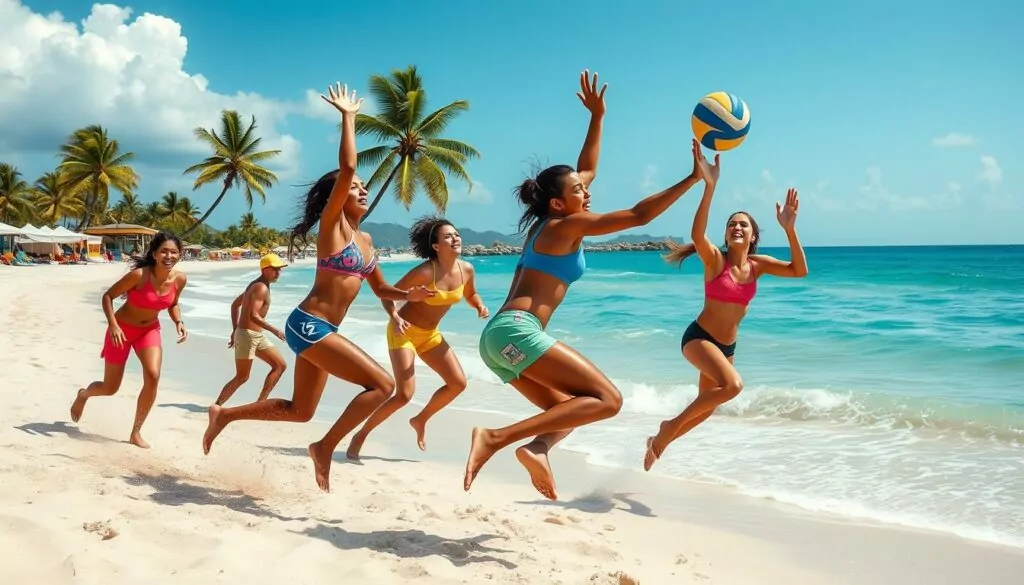
Training and Competing in Beach Volleyball
Did you know over 383,000 members join USA Volleyball? This shows how popular beach volleyball has become. To do well, you need to train and compete in many ways. This includes finding top camps and clinics and creating a training plan for the sport’s unique needs.
I’ve spent hours improving my beach volleyball skills. I’ve learned to master the game’s technical parts and prepare my mind. Training regularly and competing smartly are key to being your best. Whether you’re experienced or new, knowing how to train and compete well can change your game.
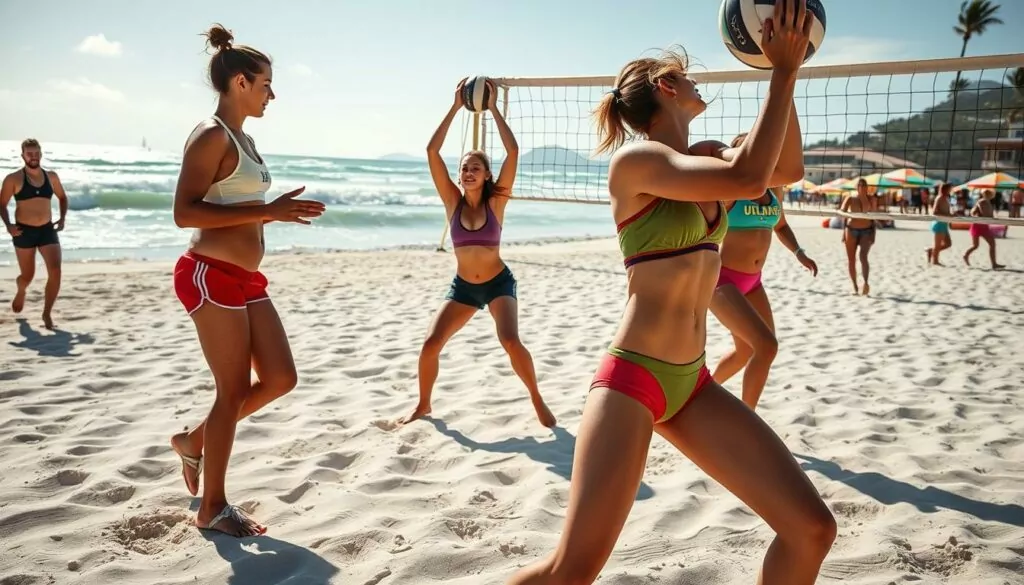
Key Takeaways
- Seek out reputable beach volleyball camps and clinics to enhance your skills and knowledge of the sport.
- Develop a well-rounded training routine that focuses on physical conditioning, technical development, and mental preparation.
- Prioritize proper nutrition and hydration to fuel your body for the demands of beach volleyball competitions.
- Learn and practice tournament preparation strategies to optimize your performance on game day.
- Embrace beach volleyball etiquette and sportsmanship to build a positive reputation and foster a welcoming community.
Finding Beach Volleyball Camps and Clinics
If you love beach volleyball, joining a training program can really help you improve. Beach volleyball camps and clinics are great for all skill levels. They let you work on your skills with the help of top coaches and players.
These programs focus on key skills like serving, passing, and hitting. They also teach the mental and strategic sides of the game. This helps players make better decisions and manage the game.
IMG Academy in Florida is a top choice for training. They offer different camps for ages 8-18. Prices start at $1,549 and go up to $2,799 for the best package.
There are many other great beach volleyball camps and clinics in the U.S. They cater to all ages and skill levels. Some focus on hitting, serving, or setting, helping you get better at specific skills.
When looking for a beach volleyball training program, think about the camp’s reputation and the coaches. Also, consider the program’s length and what you get for your money. It’s smart to book early, as spots fill up fast.
Investing in these programs can really boost your game. You’ll learn from experts and meet other athletes. Whether you’re new or experienced, there’s a camp or clinic that can help you achieve your goals.
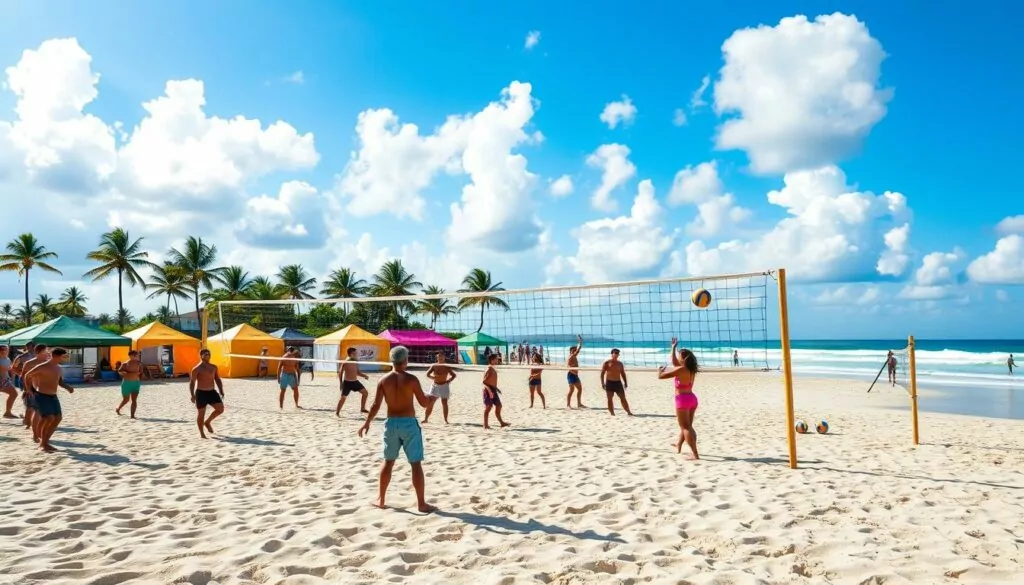
Building a Beach Volleyball Training Routine
Creating a solid training plan is key for beach volleyball players. It should mix beach volleyball strength training, beach volleyball cardio training, and beach volleyball skill-specific drills. These help players get better and stay safe on the sand. Adding sand court conditioning and functional training builds the right physical skills for the game.
Here’s a good example of a beach volleyball workout:
- Plyometric Exercises: Box Jumps, 3 sets of 10 jumps
- Strength Training: Squats, 12-15 reps, at least 3 sets
- Cardiovascular Endurance: Sprint Intervals, 30 seconds sprint, 30 seconds rest, repeat 10-15 minutes
Playing sand volleyball can burn up to 500 calories per hour. This makes it great for losing weight with a healthy diet and regular workouts. High-Intensity Interval Training (HIIT) also boosts fitness and endurance for beach volleyball players.
Adding upper body strength training like push-ups and shoulder presses is important. It helps players get strong and powerful on the sand. Agility drills, such as shuttle runs, improve speed and agility on the sand.
A good beach volleyball training plan should mix strength, cardio, and sport-specific skills. This helps players perform better and stay injury-free.
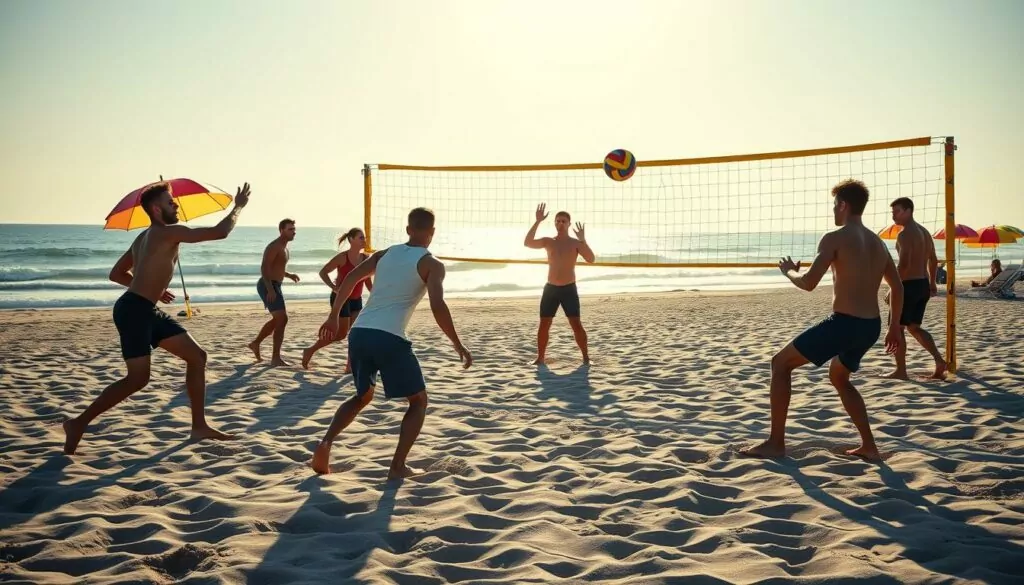
Mental Preparation for Sand Competition
Beach volleyball players know it’s not just about physical skills. Mental preparation is key to success. Techniques like visualization, goal setting, and building mental toughness help athletes handle competition’s challenges.
Visualization helps players practice their moves and game scenarios in their mind. It boosts confidence and improves decision-making. Setting clear goals also keeps athletes focused and motivated.
Mental toughness is essential for beach volleyball. The sand’s changes, the game’s demands, and the pressure can affect a player’s mind. Learning to manage stress and stay calm helps athletes perform well, even when it’s tough.
By focusing on mental training, beach volleyball players can get ahead. Visualizing success, setting goals, and building mental strength are key. These strategies can change the game for athletes aiming to excel in this challenging sport.
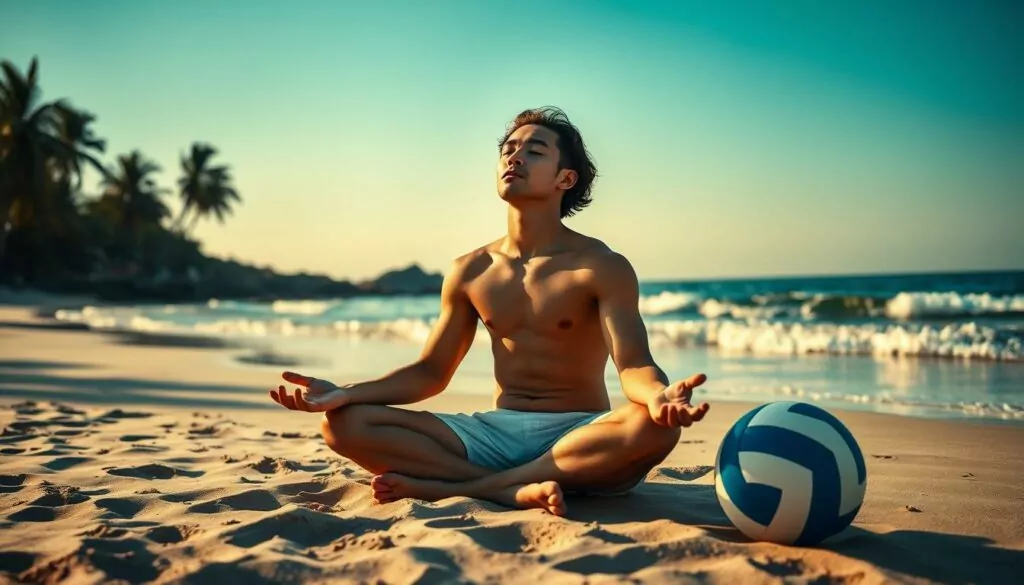
“The mental game is just as important as the physical game in beach volleyball. Developing strategies to stay focused, manage stress, and perform under pressure can make all the difference in a close match.”
– Elite Beach Volleyball Coach
| Mental Preparation Technique | Benefits for Beach Volleyball |
|---|---|
| Visualization | Boosts confidence, improves decision-making, enhances focus |
| Goal Setting | Provides a roadmap for success, keeps athletes motivated and accountable |
| Mental Toughness | Increases resilience, helps manage stress and perform under pressure |
By using these mental preparation methods, beach volleyball players can gain a big advantage. They can unlock their full competitive ability on the sand.
Nutrition and Hydration for Beach Athletes
For beach volleyball players, eating right and staying hydrated are key. They help keep energy up, prevent cramps, and aid in recovery. Drinking 8-10 glasses of water a day is important to avoid dehydration during summer sports. A diet full of carbs, protein, and healthy fats gives the energy needed for training and games.
It’s vital to drink water before, during, and after playing. Adults should drink at least eight glasses of water a day. Kids should aim for six glasses, based on their age. Athletes should drink 7 to 10 ounces of fluid every 10 to 15 minutes during play.
Replenishing electrolytes lost through sweat can help athletes perform at their best on the sand. For workouts lasting 60-90 minutes, sports drinks like Gatorade or Powerade are good. Gatorade has 14 grams of carbs per 8 ounces, which muscles use quickly.
| Hydration Recommendations | Fluid Intake | Electrolyte Replenishment |
|---|---|---|
| 8-10 glasses of water daily | 7-10 oz every 10-15 minutes during play | Sports drinks, Nuun tablets |
| 6 glasses for children | 8 oz per 15 minutes of exercise | Monitoring weight loss |
LSU beach volleyball’s coaching staff meets weekly with strength coaches, trainers, and dietitians. Each athlete gets a personalized nutrition plan, working with nutritionists and medical staff.
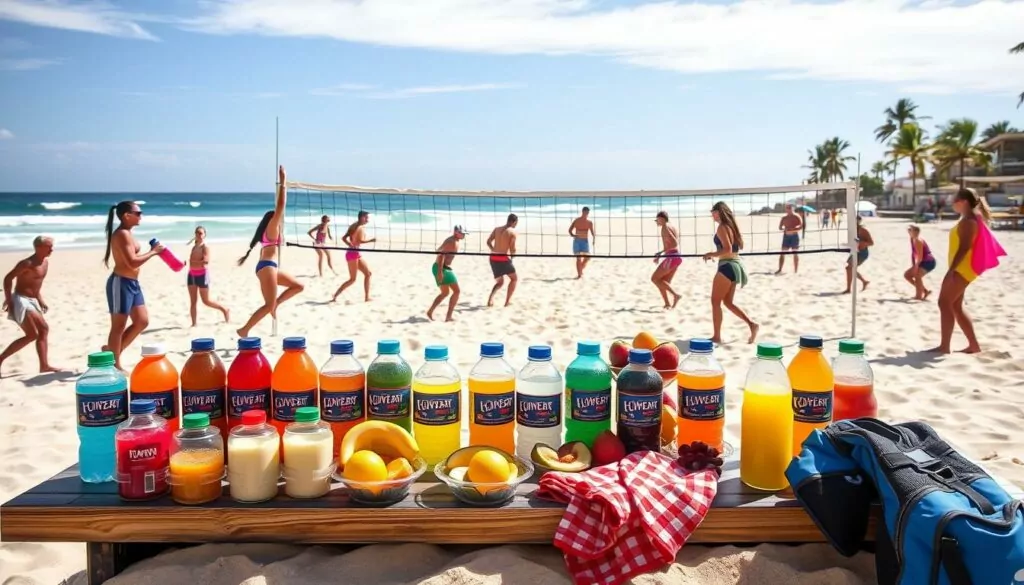
Injury prevention includes core strengthening, plyometrics, and resistance training. Physical therapists check athletes’ strength, flexibility, and movement to spot injury risks. They create custom exercise and stretching plans to lower injury chances.
Physical therapists teach athletes proper body mechanics and technique to avoid injuries. They help athletes recover safely after injuries to prevent further harm and promote health.
“Togetherness is the key to our success on the beach. We’re a tight-knit group that cares for each other both on and off the court.” – Head Coach, LSU Beach Volleyball
The team’s focus is on “togetherness,” building unity and teamwork. Coaches and trainers check in with players daily for support. The team has a family atmosphere with picnics and dinners to strengthen bonds.
Tournament Preparation and Strategies
Competing in beach volleyball tournaments needs careful planning and action. Players must manage travel and accommodations well. They also need to scout opponents and plan their games. Making changes during the game based on the situation or opponent’s strengths is key to winning.
To do well in a tournament, beach volleyball players should first learn about the event. They should book travel and places to stay early. Knowing the tournament schedule and format is also important.
Scouting opponents is vital. It helps players know their opponents’ strengths and weaknesses. This knowledge helps in planning strategies for each match.
- Develop a detailed game plan: Look at the tournament bracket, scout opponents, and plan strategies for each match.
- Practice making in-game adjustments: Be ready to change your play and tactics as needed, like due to weather or an opponent’s changes.
- Keep your mind focused: Stay calm and focused throughout the tournament, even when things get tough or stressful.
- Take care of your body: Drink enough water, eat right, and rest well to stay at your best during the tournament.
By being strategic and well-prepared, beach volleyball players can boost their chances of winning. This approach makes the competitive experience more rewarding.
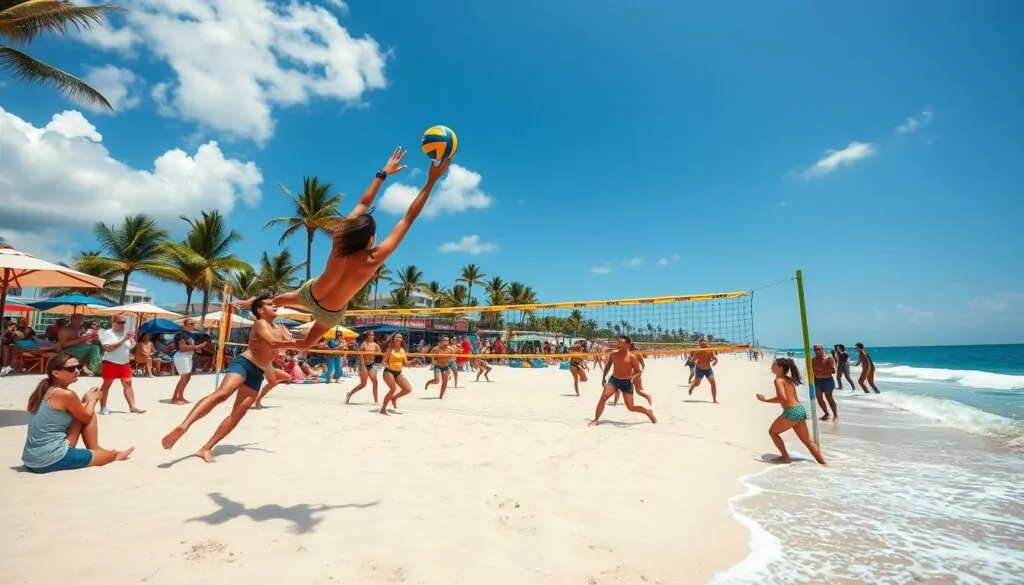
Beach Volleyball Etiquette and Sportsmanship
Playing fair and showing respect is key in beach volleyball. Players should follow the rules and act with grace, win or lose. This helps make the game fun for everyone.
Good communication is important in beach volleyball. Coaches and players should talk face-to-face more than through emails. The “24-hour rule” helps too, by waiting a day to talk about issues.
Respecting the referees is also vital. Players should value the referees’ role in keeping the game fair. Not yelling at them is part of playing fairly.
Building a positive team culture is important too. Coaches should help players grow, not just win. This makes the season better for everyone.
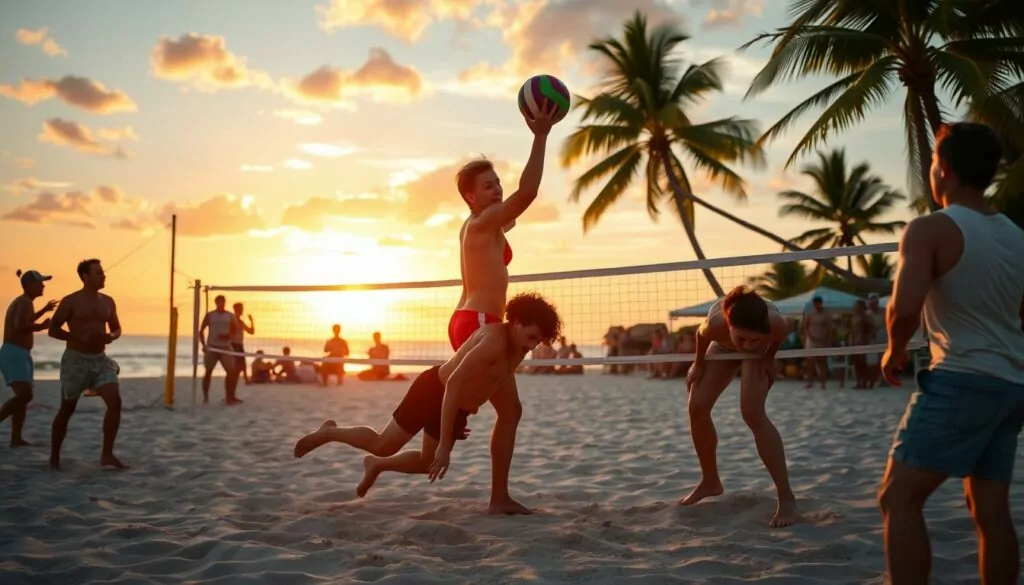
By following these rules, beach volleyball players help make the sport better for everyone. It makes the game more fun and sets a good example for others.
Advancing Your Beach Volleyball Career
Beach volleyball offers many paths for those who love the sport. You can aim for the professional level, get a college scholarship, coach, or officiate. The opportunities are vast and rewarding.
Starting a professional beach volleyball career is exciting. The sport’s popularity is growing fast. High-profile events have made it more visible, attracting 75% of pro athletes.
Aspiring players can improve their skills and network. They can try out for pro teams. New leagues, like the Beach Pro Tour, offer more chances to compete.
Getting a beach volleyball scholarship can change a young athlete’s life. It offers training, competition, and education. 60% of young players are drawn to its fast pace and teamwork.
By excelling and connecting with college coaches, players can get a chance to compete at the collegiate level.
The beach volleyball industry also offers coaching and officiating jobs. Experienced players can mentor the next generation. Officials ensure fair and safe games.
These roles are key as the sport grows. They offer exciting opportunities for those who want to contribute.
To advance in beach volleyball, you need dedication and skill. Always focus on safety and sportsmanship. By embracing the sport’s dynamic nature, you can unlock many possibilities and make a lasting impact.
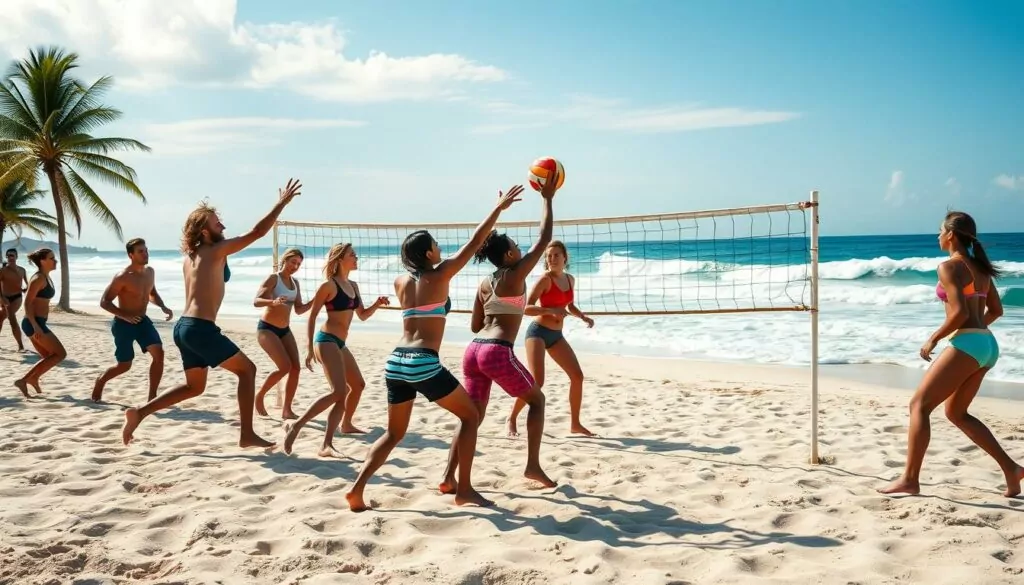
“Beach volleyball has given me the opportunity to compete at the highest level, travel the world, and inspire the next generation of athletes. It’s a journey filled with passion, dedication, and an unparalleled sense of community.” – Kerri Walsh Jennings, 3-time Olympic gold medalist
Conclusion
Success in beach volleyball needs a mix of physical training, mental strength, strategy, and a strong commitment to fair play. Knowing how to prevent injuries helps athletes avoid setbacks and improve their skills. Staying hydrated, eating right, and using good recovery methods also boost performance and endurance.
Beach volleyball is a favorite sport worldwide. It offers many chances for athletes to grow and advance in their careers. To succeed, one must be dedicated, resilient, and always looking to get better.
By following the rules of beach volleyball, athletes can reach their goals and help the sport grow. Their commitment to fair play and excellence can inspire others. This way, they make a lasting impact and encourage future athletes to strive for greatness.
FAQ
What are the three most common acute injuries in beach volleyball?
The top three acute injuries in beach volleyball are ankle, knee, and finger injuries.
What are the most prevalent overuse injuries in beach volleyball?
Overuse injuries often include lower back pain, shoulder pain, and patellar tendinitis.
Why is a proper warm-up important for beach volleyball players?
A good warm-up is key to avoiding injuries. It includes isometric exercises, jogging, and dynamic stretching. These activities prepare the muscles for the game.
How can knee injuries be prevented in beach volleyball?
To prevent knee injuries, wear proper gear like patellar tendon straps and knee pads. Knee braces offer extra support and stability, reducing injury risk.
What can beach volleyball players do to prevent ankle injuries?
Preventing ankle injuries involves using ankle braces or taping. Training on a proprioceptive balance board also helps reduce ankle sprains.
Why is sun protection important for beach volleyball players?
Playing outdoors means facing UV rays. Wearing sunscreen, sun hats, and sunglasses is vital. It prevents sunburns, skin damage, and skin cancer.
How can beach volleyball players ensure proper hydration and nutrition?
Staying hydrated and well-nourished is critical. Drink water before, during, and after play. Use sports drinks for extra electrolytes. Eat a balanced diet for energy and recovery.
What recovery techniques are important for beach volleyball players?
Rest and recovery are vital. Use foam rolling, massage guns, and resistance bands. Also, get enough sleep and focus on nutrition and hydration for muscle recovery.
